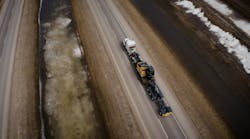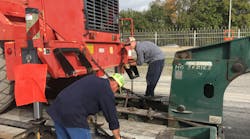"A lot of times contractors view trailers as a necessary evil to get their equipment from Point A to Point B," says Jerry Rothwell, an Ohio-based key dealer manager for Fontaine Trailer Co., Haleyville, Ala. "They have a $150,000 piece of equipment, say an excavator, and they want to haul it on a $2,000 trailer. That just doesn't get it," he says.
One reason trailer purchases, in Rothwell's words, "are one of those things contractors are stand-offish about as far as laying the money down for it is because trailers are not revenue producing pieces of equipment in their fleet."
However, smart contractors, says Rothwell, "will step up to the plate and do the right thing. They'll buy the trailer that's right for what they need to haul and then parlay that into hauling things for other guys."
A good example, he says, is what's going on in Oregon and the state of Washington. "A lot of platform trailers are being bought to haul lumber out of the area to the Midwest," he says. "In the Midwest the trailers are used to pick up steel and haul it back to Oregon or Washington."
Rothwell points out, "The main reason they're buying trailers is to haul lumber, but they also want to generate revenue by looking at what they can haul back."
Construction contractors, whose most common mistake is not doing their homework when it comes to purchasing trailers, must know their load and where they are going to haul it, says Rothwell. This is a critical factor, he says.
Contractors should also understand that buying, for instance, a 50-ton trailer doesn't mean he can haul 50 tons legally. He needs to know the regulations, both local and federal, that apply to the region where he's hauling.
Mark Kulyk, president of Rogers Brothers Corporation, a 101-year-old, family-owned trailer manufacturing company in Albion, Pa., zeros in on one factor that many contractors don't know and some trailer manufacturers never bring up in conversation, he says. That is load concentration.
"As an analogy," Kulyk comments, "a 100-ton crane won't pick up 100 tons with the boom extended. It is capable of picking up 100 tons, but it would be in an almost perpendicular position with the load right in the operator's face."
It's the same with trailers, he says. A high lift trailer might be rated at 80,000 pounds over its entire length. But its concentrated load is 60,000 pounds within 16 feet on either side.
For example, Rogers, says Kulyk, makes two types of 50-ton low-bed trailers with 24-foot decks. "We say 50 tons should be carried in the center of the deck, 6 feet on either side. That's a half-deck concentration. We also offer two-thirds deck concentration. You can carry 50 tons within 16 feet of the deck."
That's why, Kulyk says, when a contractor asks for a 50-ton trailer, Kulyk says he always asks what the load concentration is. "He won't necessarily get that conversation from everybody. They'll just sell him a 50-ton trailer."
Types of trailers that haul construction equipment go by different names, depending on the geographical region of the fleet. Some are called skidders (drop-decks), lowboys, flatbeds, tag-alongs, and goosenecks, for instance. But, basically, according to Kulyk, such units can be broken down into three basic types — tag-alongs that generally are pulled behind dump trucks, fixed goosenecks that load from the rear and detachable goosenecks that are front loaders. Both types of goosenecks are fifth-wheel type trailers Kulyk explains.
For construction equipment, the trailer universe is divided into these types, he comments. Although there are a lot of trailers that can be loaded by cranes or backed up to docks where fixed machines (such as one arriving from overseas) can be loaded, these types fall more into the realm of transportation trailers, says Kulyk.
Semi trailers that connect to the fifth wheel of a pulling tractor are more construction equipment oriented. Fixed goosenecks that load from the rear, in most situations, are level with a height slightly higher than the trailer tires.
"The load comes up over the beaver tails in the back, and rests on the level deck," Kulyk explains. "These trailers tend to be a lower capacity because the loads they haul are shorter." With these type trailers, he says, the deck height is anywhere from 34 inches to 36 inches or 39 inches. "So the equipment that is hauled on it needs to be slightly shorter to go under bridges, for instance," he says.
Fixed gooseneck trailers also come in a drop deck configuration. "The equipment being loaded comes up over the wheels," says Kulyk, "and drops into a well that is 20 feet to 24 feet down inside and rests between the gooseneck and the tires."
Kulyk says fixed goosenecks in today's market tend to be used for lighter loads, "that are not quite as tall." Operators like rear loading goosenecks, he points out, because they can flip down the ramps or power hydraulic ramps down, load the equipment, raise the ramps, and take off.
Front loaders, by comparison, have detachable or folding goosenecks. In other words, the gooseneck stays with the tractor. That allows a large piece of equipment to be loaded over the front.
"As machines got larger," says Kulyk, "they became less desirable to load in the back. You've got to climb a higher distance, about 39 inches, for example. You're moving a large machine up over the back. With a detachable gooseneck, by contrast, you have a 7-inch initial step using a front loading ramp. You might have a 14-inch or 16-inch key beam, but you're not trying to negotiate a very tall climb at all."
Front loaders are used for large excavators, bulldozers and track equipment. When you are loading a piece of track equipment, says Kulyk, the tracks stay in one place. This means, as you climb, you reach a point where the tracks are anywhere from 6 inches to 12 inches away from the deck.
Says Kulyk, "When it reaches the tipping point, it comes down. It's a little bit nerve racking," he says. "You climb and climb and climb, and then suddenly, bang, it comes down. We watch the slope of our fronts," says Kulyk, "so it doesn't have quite as much crash. I've seen some trailers that have a steep incline and there is really a crash — but the point is you're always going to have a tipping point. The larger the equipment, the more hair-raising that tipping point can be."
Equipment operators many times like rear loading styles, Kuylk says, because it's quicker — not necessarily easier — to load. "You don't have to worry about disconnecting the gooseneck. You flip the ramps down, load, flip the ramps up, and you're through."
However, once operators get use to front loaders, they wouldn't dream of loading over the back, says Kulyk. "It's much more comfortable with the front load," he comments. "When you do it twice a day, you become pretty skilled and it's almost mechanical."
When it comes to hauling construction materials and supplies, such as sheet rock, sometimes it boils down to whatever is available to the contractor, Kulyk remarks. "Many times the contractor isn't bringing in the supplies, anyway. Somebody else does that. The contractor brings in the equipment."
Jerry Rothwell at Fontaine sums it up this way: "The primary types of trailers used for construction equipment ranges, from smallest to largest, utility trailers used by small contractors; gooseneck style trailers for medium-sized contractors; and tag-alongs, a drive bar type trailer, pulled mostly by dump trucks. A tag-along is used by municipalities and rental yards."
He adds, "If you've been in the industry for 15 years and your dad did it and your grandfather did it, it's good to jump back in there and re-educate yourself prior to making a buying decision."
You may know the basics, of course, he says, but there are changes in regulations and changes in trailer design that make a refresher course essential.




